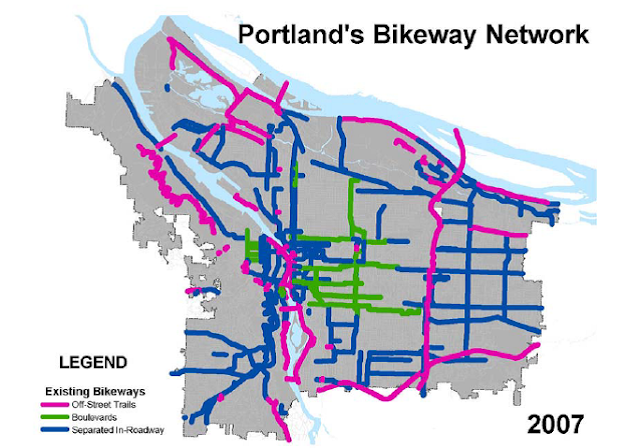The city of Portland, Oregon in the USA is one of , if not the most progressive cities in North America when it comes to building bicycle infrastructure. While it pales in comparison to Copenhagen, Portland has managed to build a network enticing enough to have raised the bicycle-to-work/study share up to 6% which is remarkable if you understand that "Portland was a city like any other US city in the 1980s and early 1990s in terms of transportation behavior". (Although we've heard they only do their bike count in June, not like Copenhagen, for example, that counts at over 40 permanent locations and another 160 intermittent locations, but we'll leave that alone for now.)
In other words addicted to the car; though to be fair, Portland did build one of the first post-WW2 Light Rail lines in North America in 1986 and did so by using monies that were originally aimed at widening what Oregon calls a "freeway".
This has come at a "great" financial cost of course, the total being an estimated US$60 Million, which is a lot of money...
...until you realize what the extension or widening of limited-access divided-highways cost.
And in the case of Portland, US$60 million is also what 1 mile (1.6 km) of "freeway" costs to build. Now, to be honest, highway projects in the USA vary in price so look at this report and remember that these prices are per "lane-mile" (if the proposed "freeway" is going to have 3 lanes in each direction, multiply these numbers by 6).
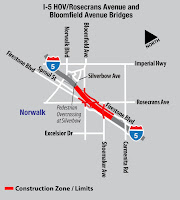 Widening roads is not cheap either. A news item this week announced that 1.2 miles (1.93 km) of road in Los Angeles county would have a Carpool Lane and a General Purpose Lane added in each direction for just US$214 million(!) An underpass designed to eliminate an at-grade or level crossing in Orange County California is penciling is at US$92 million.
Widening roads is not cheap either. A news item this week announced that 1.2 miles (1.93 km) of road in Los Angeles county would have a Carpool Lane and a General Purpose Lane added in each direction for just US$214 million(!) An underpass designed to eliminate an at-grade or level crossing in Orange County California is penciling is at US$92 million.But you won't hear much about the costs of those projects as they are built for the bull in society's china shop, the automobile; because the mainstream media in the USA (and increasingly elsewhere) ignores the bull but then scrutinizes the costs of bicycle and railway facilities.
CNN's domestic USA service (which is very different from that which you may encounter with the CNN logo outside North America) recently ran a report critical of the spending of public funds to upgrade a railway in the Northeastern State of Vermont on a show hosted by Anderson Cooper (Cooper is, ironically, the Great-Great-Great-Grandson of railroad builder and magnate Cornelius Vanderbilt)
The piece has been roundly criticized by many for being out-of-touch with reality, the best critique being made by DC.Streetsblog's Tanya Snyder who defended the rail improvements for having "spent .00006 percent of the federal stimulus money on needed track improvements and came in on time and under budget." The cost to the taxpayers of this "outrageous railway boondoggle"?
US$52 million.
Remember what the Portland Bicycle Infrastructure cost?
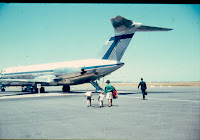 |
| Typical service before deregulation |
 |
| Air Greenland now arriving! |
The CNN piece focused on a train called "the Vermonter" which runs from Saint Albans near the border with Quebec, (a previous incarnation of this train used to serve Montreal) down to Essex Junction a stop near to Vermont's largest city Burlington, thence to White River Junction, a city near Hanover, New Hampshire, the home of Dartmouth College. It then mostly follows the Connecticut River, which divides Vermont from New Hampshire, south into Western Massachusetts through to New Haven, Connecticut. At this point the train joins the busy Northeast Corridor to New York City and finally ends up in Washington, D.C.
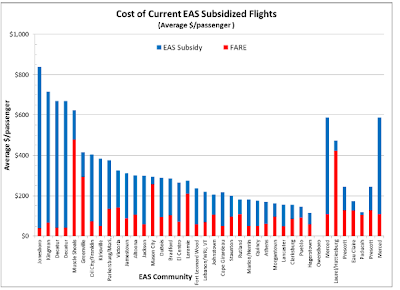 |
| Source: M.J. Bradley & Associates for NRDC |
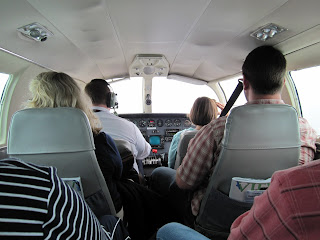 |
| Only one pilot today! |
This EAS Subsidy does not include the financial support from City of Lebanon to the airport itself, derived from property taxpayers due to the financial structure of New Hampshre, or the US$1 million that the federal government grants each year to the airport for "improvements", or the airport's traffic control tower, as it is part of the national air traffic control system. Both of these fundings are based on the existence of the EAS flights. And since the Boston flights arrive into a "secure" gate there, the Lebanon Airport must have airport security screeners present for those departures, which are paid for through a ticket fee. However at around 6,000 "enplanements" for Boston at US$2.50 per, that's not generating very much money per year, so funding and capital for the security is coming from elsewhere.
EAS rules requires that at least 10,000 passengers board the subsidized flights each year; something which was only pulled off by Lebanon in 2012 by using steeply discounted fares during the last week of the year. This situation made for a fun day trip (sponsored by the taxpayers to the tune of US$230 each way (The US$2.3M annual EAS subsidy to Cape Air divided by 10,000)) from Lebanon to White Plains for one member of the Airliners.net forum who wrote a trip report about it. One way fares on these flights are normally in the US$130 range. It is touted as a means to access businesses in the area for those who are unwilling to take the bus (see above) from Boston's airport or drive the 76 miles (123 km) from the one in Manchester, New Hampshire.
However, I will confess that the fully Wheelchair-accessible 206-seat train, which could operate with many more cars equaling many more seats, requires US$2.7 million in subsidies to operate. That's still less than the two daily nine-seat airplanes plus their share of the associated Lebanon airport cost to fly to White Plains (I'll ignore the federally-supported costs of Westchester County Airport since it handles many more and larger aircraft operations) And, yes, the rail project project mentioned was only for Vermont. There are other projects in Massachusetts and Connecticut, admittedly at additional cost, that will result in even further time savings for the trip as a whole along the entire Vermont to New Haven corridor as well as the potential to add more frequency of service. But then one should note that this rail corridor that the Vermonter uses north of New Haven is owned by privatecompanies who also contributed funding to the project, and despite the public funding for improvements, unless there is an exemption I am not aware of, these private railroads pay property tax on the land their rail "right-of-ways" occupy. If you are reading this in the USA, go someday to your local property tax collector and ask who the largest property tax payer is in that municipality or county. If there is one, it is usually the railroad who owns the local rail line. Is there property tax levied on airports and roads? No!And in regards to capital expenses, I can't begin to speculate what it would cost to buy the land for the Lebanon Airport today and then build the terminals from scratch.
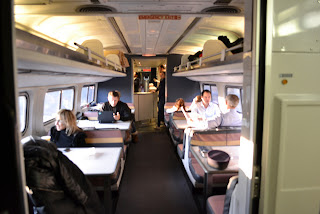 |
| Might get some work done. |
Rail lives (or dies) on intermediate market business, this is what it does best given the ability to stop in cities along the way without the aforementioned time and distance penalties. Remember neither the airplane nor the bus can do what this train does, connecting not only Burlington, Vermont to Washington, but also Wallingford, Connecticut to Waterbury, Vermont or Hanover, New Hampshire to Amherst, Massachusetts (also home of educational institutions), and this part of the world to the rest via New York City, et cetera, et cetera. And you can bring your bike along, and your laptop, and buy a beer.
All for less than the cost of an underpass.
